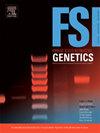Accounting for inter-laboratory DNA recovery data variability when performing evaluations given activities
IF 3.1
2区 医学
Q2 GENETICS & HEREDITY
引用次数: 0
Abstract
A large, recently published, inter-laboratory study by the ReAct group has shown that there is considerable variability in DNA recovery that exists between forensic laboratories. The presence of this inter-laboratory variability presents issues when one laboratory wishes to carry out an evaluation and needs to use the data produced by another laboratory. One option proposed by the ReAct group is for laboratories to carry out a calibration exercise so that appropriate adjustments between laboratories can be made. This will address some issues, but leave others unanswered, such as how to make use of the decades of transfer and persistence data that has already been published. In this work we present a method to utilise data produced in other laboratories (whether it provides DNA amounts or a probability of transfer) that takes into account inter-laboratory variability within an evaluation. This will allow evaluations to continue, without calibration data, and ensures that the strength of findings is appropriately represented. In this paper we discuss complicating factors with the various ways in which previous data has been reported, and their limitations in supporting probability assignments when carrying out an evaluation. We show that a combination of producing calibration information for new data (as suggested by the ReAct group) and development of strategies where calibration data is not available will provide the best way forward in the field of evaluations given activities.
在进行特定活动评估时,考虑实验室间 DNA 复原数据的差异
ReAct小组最近发表的一项大型实验室间研究表明,法医实验室之间的DNA恢复存在相当大的差异。当一个实验室希望进行评估并需要使用另一个实验室产生的数据时,这种实验室间可变性的存在就会产生问题。ReAct小组提出的一种选择是让实验室进行校准工作,以便在实验室之间进行适当的调整。这将解决一些问题,但没有解决其他问题,例如如何利用几十年来已经发布的传输和持久化数据。在这项工作中,我们提出了一种方法来利用其他实验室产生的数据(无论是提供DNA数量还是转移概率),在评估中考虑到实验室间的可变性。这将允许在没有校准数据的情况下继续进行评价,并确保适当地表示调查结果的强度。在本文中,我们讨论了复杂的因素与各种方式,其中以前的数据已经报告,并在执行评估时,他们在支持概率分配的局限性。我们表明,为新数据提供校准信息(如ReAct小组所建议的)和制定无法获得校准数据的策略相结合,将为给定活动的评估领域提供最佳的前进方式。
本文章由计算机程序翻译,如有差异,请以英文原文为准。
求助全文
约1分钟内获得全文
求助全文
来源期刊
CiteScore
7.50
自引率
32.30%
发文量
132
审稿时长
11.3 weeks
期刊介绍:
Forensic Science International: Genetics is the premier journal in the field of Forensic Genetics. This branch of Forensic Science can be defined as the application of genetics to human and non-human material (in the sense of a science with the purpose of studying inherited characteristics for the analysis of inter- and intra-specific variations in populations) for the resolution of legal conflicts.
The scope of the journal includes:
Forensic applications of human polymorphism.
Testing of paternity and other family relationships, immigration cases, typing of biological stains and tissues from criminal casework, identification of human remains by DNA testing methodologies.
Description of human polymorphisms of forensic interest, with special interest in DNA polymorphisms.
Autosomal DNA polymorphisms, mini- and microsatellites (or short tandem repeats, STRs), single nucleotide polymorphisms (SNPs), X and Y chromosome polymorphisms, mtDNA polymorphisms, and any other type of DNA variation with potential forensic applications.
Non-human DNA polymorphisms for crime scene investigation.
Population genetics of human polymorphisms of forensic interest.
Population data, especially from DNA polymorphisms of interest for the solution of forensic problems.
DNA typing methodologies and strategies.
Biostatistical methods in forensic genetics.
Evaluation of DNA evidence in forensic problems (such as paternity or immigration cases, criminal casework, identification), classical and new statistical approaches.
Standards in forensic genetics.
Recommendations of regulatory bodies concerning methods, markers, interpretation or strategies or proposals for procedural or technical standards.
Quality control.
Quality control and quality assurance strategies, proficiency testing for DNA typing methodologies.
Criminal DNA databases.
Technical, legal and statistical issues.
General ethical and legal issues related to forensic genetics.

 求助内容:
求助内容: 应助结果提醒方式:
应助结果提醒方式:


